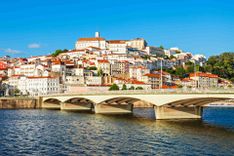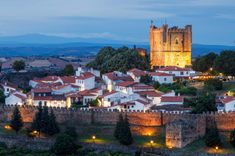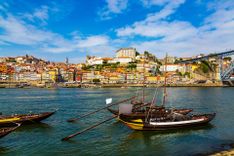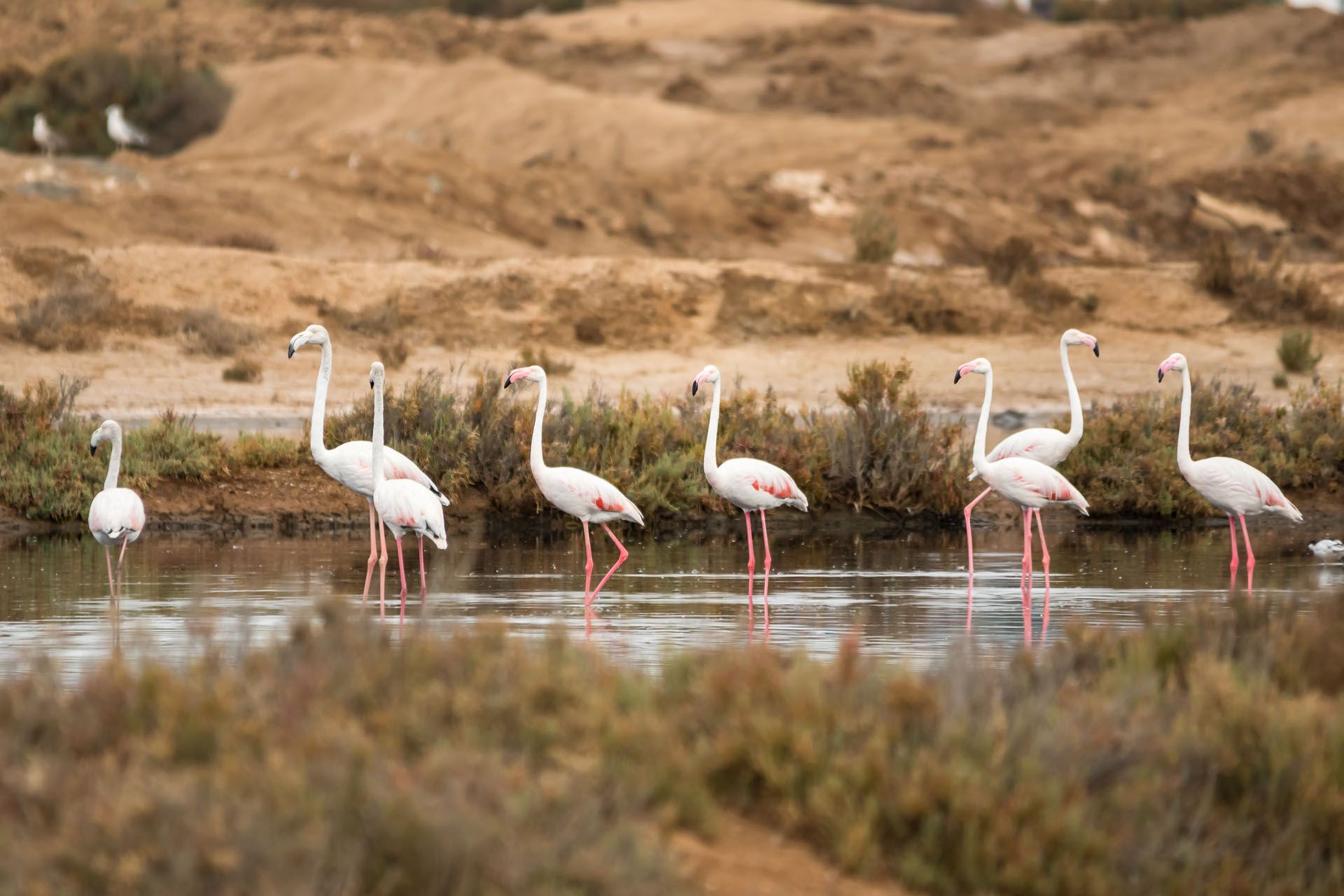Planning your own trip? Prepare for your trip
Use Rough Guides' trusted partners for great rates
- Portugal
- Tavira
Plan and book your private, tailor-made tour with vetted local experts
Tavira, 30km east of Faro, is the Algarve at its most elegant. The Rio Gilão cuts through the center, with whitewashed mansions, hipped rooftops, and wrought-iron balconies on both banks. It’s easy to linger here longer than planned, especially once you’ve taken the short ferry to Ilha de Tavira, a long sweep of sand backed by dunes and pines. The town’s past runs deep: founded around 400 BC, it was once a Moorish stronghold and later a busy port trading with North Africa until the river silted up in the seventeenth century.
Today you’ll find graceful eighteenth-century townhouses rebuilt after the Great Earthquake of 1755, cobbled lanes leading to more than twenty churches, and doorways with knockers shaped like hands. Seafood lovers head to nearby Santa Luzia, known for its octopus dishes, while quieter sands lie at Barril and Pedras d’el Rei, both just a short hop west of town.

Hey, I’m Joel, your Portugal travel expert, and Tavira is one of the Algarve’s most graceful towns. Straddling the Rio Gilão, it’s a place where whitewashed mansions, cobbled lanes, and more than twenty churches meet an easygoing riverside rhythm. This Tavira travel guide will give you the essentials: how to get there, when to go, and where to stay.
The best way to enjoy Tavira is slowly. Take the ferry out to Ilha de Tavira for one of the Algarve’s finest beaches, linger over grilled octopus in nearby Santa Luzia, and wander the backstreets where door knockers are still shaped like hands. The obvious highlights are the old Roman bridge, the castle gardens, and the eighteenth-century townhouses, but it’s often the smaller details that stay with you: the clatter of storks on chimneys, the scent of orange blossoms, and evenings when the riverfront glows in the last light.
Joel’s tip
Catch the first ferry of the day to Ilha de Tavira. You’ll have a quiet stretch of sand almost to yourself before the late-morning crowds arrive.
Best time to visit
How to get to Tavira
Tavira is 30 km east of Faro, about a 35-minute drive. Trains and buses run regularly from Faro and take under an hour. From Lisbon, it’s a three-hour train ride to Tavira station, a short walk from the center. A car is useful if you want to explore nearby beaches, villages, and the Ria Formosa Natural Park.
Best areas to stay in Tavira
Tavira sits in Portugal’s eastern Algarve, about 30 km east of Faro and just 25 km from the Spanish border. The town straddles the Rio Gilão, with its old bridge linking both banks, and is surrounded by the lagoons and islands of the Ria Formosa Natural Park. From Faro, it’s an easy 35-minute drive or a short hop by train along the Algarve line.
Often listed among the best places to visit in Portugal, Tavira combines history, culture, and coast in one neat package. From here, you can take the ferry to Ilha de Tavira for long sandy beaches, wander the fishing village of Santa Luzia for octopus dishes, or head inland to explore rural Algarve villages. Spain is just across the Guadiana River, making Tavira an ideal stop on a wider Portugal itinerary that blends Algarve sunshine with cross-border day trips.
















Tavira is compact, flat, and easy to explore on foot. Most of the old town sits on either side of the Rio Gilão, linked by the Roman bridge, so wandering between churches, cafés, and riverside squares is straightforward. To reach the beaches and nearby villages, you’ll need boats, bikes, or short drives.

Forte de São João da Barra, Cabanas de Tavira, Algarve © Russ Heinl/Shutterstock
If you’re asking how many days in Tavira are enough, one full day will let you see the old town highlights: the Roman bridge, castle gardens, and a handful of the town’s twenty-one churches. You can stroll the riverfront, cross both banks, and take a ferry to Ilha de Tavira for a few lazy hours on the sand. If your trip to Portugal takes you through the Algarve, Tavira’s a laid-back stop worth making.
But Tavira really rewards a longer stay. Two to three days gives you time to explore at a relaxed pace: a day in the old town, a day on the beaches of Ilha de Tavira or Barril, and another wandering through the fishing villages of Santa Luzia or Cabanas. If you’re planning a 10-day Portugal itinerary, staying in Tavira makes sense; it’s a great base for combining history, food, and some of the best beaches in Portugal. Evenings are particularly atmospheric when the riverfront fills with diners and storks clatter on the rooftops.
Tavira has a wide range of places to stay, from boutique hotels in whitewashed mansions to simple guesthouses tucked into quiet lanes. Here’s where to base yourself depending on how you like to travel.

Praia Tavira @ Shutterstock
Tavira is more than just another Algarve town. It has Moorish history, quiet lanes scented with orange blossom, and a string of barrier-island beaches that many still miss in favor of busier resorts. Here’s the in-depth guide to the best things to do in Tavira, with plenty of reasons to linger.
The so-called Roman Bridge has been rebuilt countless times, most recently in the 17th century, but it remains Tavira’s beating heart. By day, school kids cross on their way home, and fishermen lean over the railings to watch mullet flash in the Gilão. By evening, musicians set up on the cobbles and couples stroll hand-in-hand while the water turns gold. Come back after dark, the bridge lamps reflect in the river, and you’ll see why locals never tire of the view.
From the middle of the bridge, look upstream. The jumble of whitewashed houses with hipped “tesouro” roofs is pure Tavira; this Moorish-influenced roof style is unique to the town.
The castle ruins don’t look like much from outside, but step through the gate and you’ll find one of Tavira’s loveliest surprises: a small garden full of bougainvillea, lemon trees, and quiet benches. Kids chase lizards along the stone paths while adults rest in the shade. From the battlements, you’ll spot storks nesting on church towers and the Ria Formosa glinting in the distance.
Next door, the Câmara Obscura is worth a detour. The live periscope view sweeps across town in real time; you’ll actually see people crossing the bridge, gulls circling, and the tide pulling through the estuary.
For a small town, Tavira has an astonishing number of churches, more than twenty. Each tells part of its story. The Igreja da Misericórdia is lined with 18th-century azulejos that show scenes of charity, strikingly blue and white in the cool interior. Santa Maria do Castelo, built on the site of a mosque, holds the tombs of seven knights whose deaths sparked Tavira’s reconquest. Others, like São Sebastião, hide delicate Manueline doorways or weathered frescoes.
Don’t just look at the façades, many doors are open during the day, and inside you’ll often find a lone local in prayer, a reminder that these aren’t just monuments but still-living places of faith.

Fisherboats at the beach Natural Park Ria Formosa - Algarve - Portugal © Michael Schroeder/Shutterstock
The ferry ride is short but sets the mood; you leave the tiled town behind, glide past saltpans where flamingos wade, and dock at a barrier island with 11 km of beach. Ilha de Tavira is family-friendly, with cafés, boardwalks, and calm water close to the pier. Walk further along and you’ll find quieter stretches where you can claim your own patch of sand.
If you’re staying in town, go early evening. The last boats leave around sunset, and the crowds thin out by then. You’ll often have the sands to yourself, with only gulls for company.
Santa Luzia feels more like a working village than a resort. Fishermen still haul octopus pots from the estuary, and the smell of grilling wafts from waterfront terraces. Lunch here is a must: try polvo à lagareiro, where octopus is roasted with garlic and olive oil until tender, or polvo rice, rich and comforting.
From Santa Luzia, it’s a flat 20-minute walk along the old railway line to Praia do Barril, making it one of the easiest ways to combine seafood and beach in a single afternoon.
Yes, it’s touristy, but something is endearing about the little open-air train that rattles across the salt marshes to Praia do Barril. The beach itself is vast, with fine sand and shallow water, but what sets it apart is the Cemitério das Âncoras, hundreds of rusting tuna-fishing anchors arranged in rows on the dunes. It’s a haunting, beautiful memorial to the community that once depended on tuna.
Skip the train on the way back and walk instead. The path crosses tidal flats where you can spot crabs, egrets, and sometimes flamingos.
The Ria Formosa is a labyrinth of lagoons, mudflats, and shifting sandbanks that shelters both wildlife and fishing communities. Boat trips from Tavira can take you birdwatching, island-hopping, or simply drifting through the marshes. Flamingos, spoonbills, and oystercatchers are common, and in winter, you might spot thousands of migrating birds resting here.
Ask about a stop in Cabanas, a sleepy fishing village east of Tavira, where time moves more slowly. Have a coffee on the waterfront before rejoining the boat.

A group of flamingos in Ria Formosa © Taniaaraujo/Shutterstock
Once Tavira’s main fish market, this handsome 19th-century iron-and-glass building now hosts craft stalls, cafés, and occasional exhibitions. It’s a pleasant place to browse ceramics, local olive oils, and handmade textiles.
Come in the morning for fresh fruit juice and people-watching. Tavira’s real food market is across the river on Avenida Dom Manuel I, where locals buy fish straight from the boats. It’s gritty, noisy, and the best spot to understand the town’s rhythms.
Tiny Cacela Velha sits on a clifftop east of Tavira, barely more than a handful of white houses and a small church. But its view is enormous: turquoise shallows stretch out like a watercolor, and sandbanks shift shape with every tide. Below lies Praia de Cacela Velha, often called one of the best beaches in Portugal. To reach it, you either wade at low tide or hop a boat across.
Visit at dusk. The clifftop square fills with neighbors chatting, and the sky turns violet over the lagoon, it feels like a painting come to life.
Tavira isn’t about big clubs or neon bars. Evenings here are about strolling along the river, finding a table outside a tasca, and listening to the clatter of storks on the church towers. Order a cataplana (a seafood stew cooked in a copper pot), share grilled sardines, and let the night unfold at a pace that feels like Tavira itself: unhurried, warm, and quietly memorable.
In summer, free fado concerts often pop up in small squares. They’re informal, intimate, and one of the best ways to end a Tavira evening.
Tavira has a classic Mediterranean climate shaped by its position on the Algarve coast. Summers are long, hot, and sunny, while winters are mild with only occasional rain. Sea breezes from the Atlantic keep summer heat more comfortable than in inland towns, and the salt marshes of the Ria Formosa create a unique light and microclimate. Average temperatures range from about 54°F (12°C) in January to 86°F (30°C) in August, with sea temperatures warm enough for swimming from late May through October.
Tavira’s food scene reflects its setting between the sea and the fertile Algarve hinterland. Expect fresh seafood, octopus from the nearby fishing village of Santa Luzia, and seasonal produce from local farms. Meals are simple, flavorful, and best enjoyed slowly on a riverside terrace or in a family-run tasca tucked into the old town.
Here are some unique experiences we can arrange for your tailor-made Tavira trip: all private, flexible, and designed by our local travel experts.
Discover Portugal's most captivating stories
Use Rough Guides' trusted partners for great rates
written by
Olga Sitnitsa
Online editor at Rough Guides, specialising in travel content. Passionate about creating compelling stories and inspiring others to explore the world.